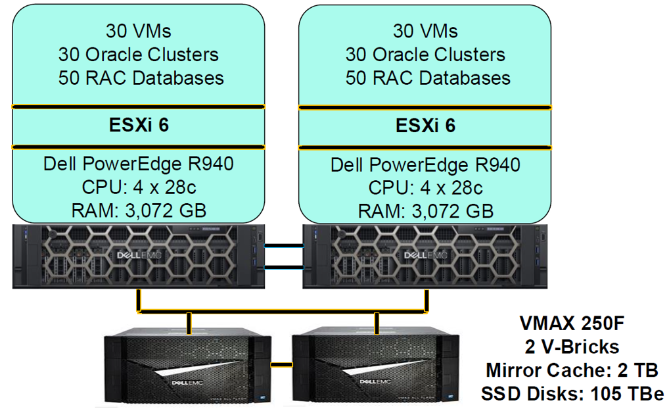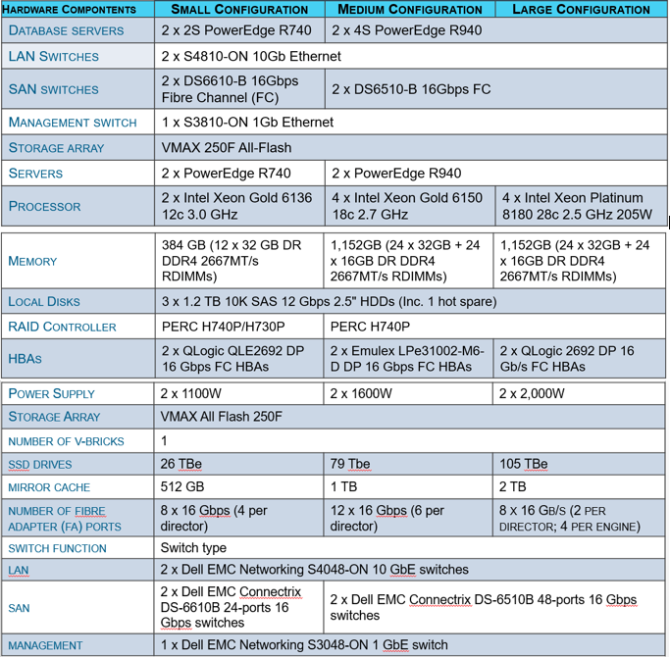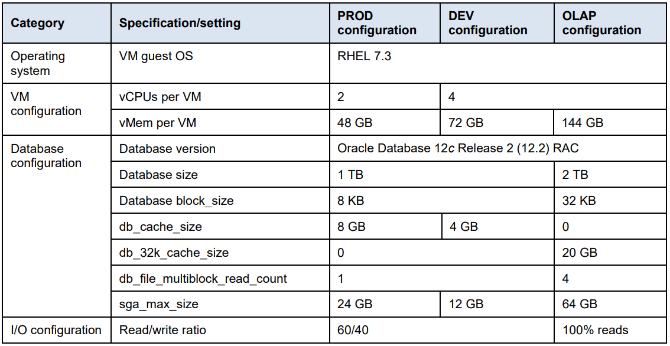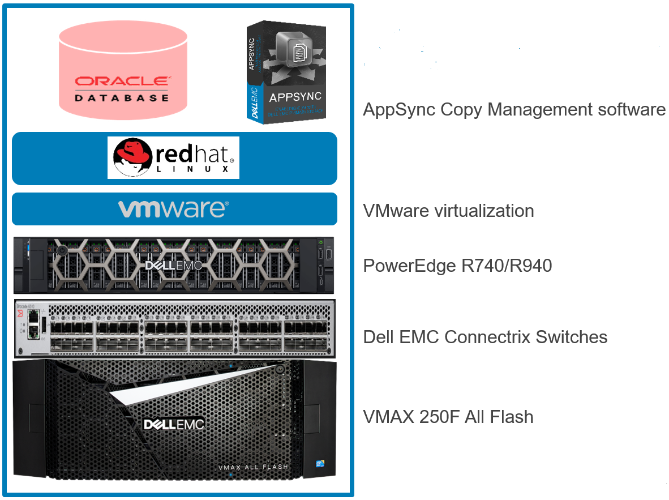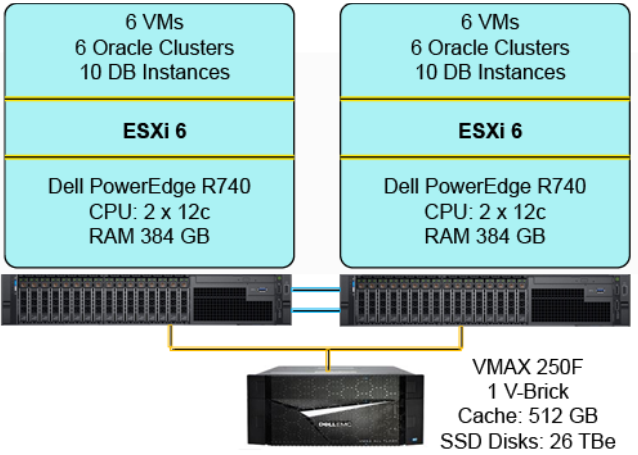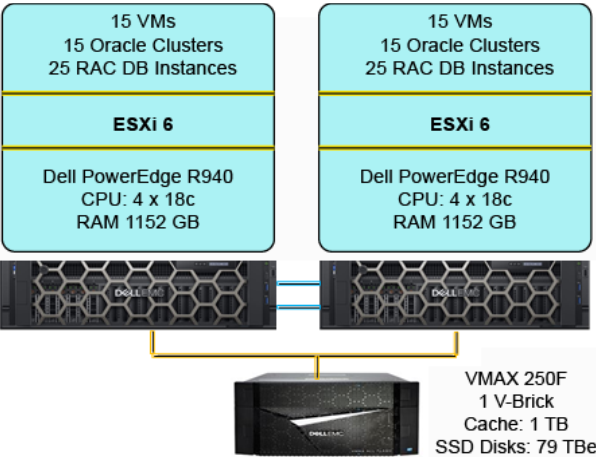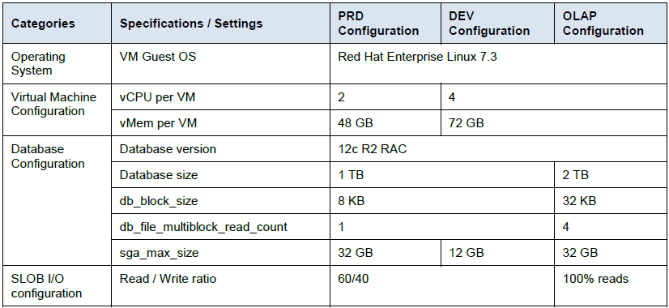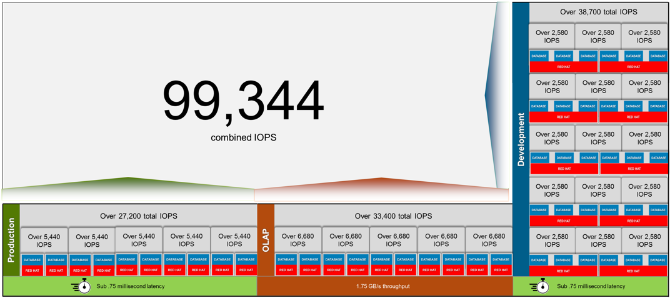

The best of all worlds: Dell EMC Ready Solution for Oracle (Part IV)
Fri, 09 Dec 2022 20:07:51 -0000
|Read Time: 0 minutes
The best of all worlds: Dell EMC Ready Solution for Oracle (Part IV)
In the last three blogs (Part I, Part II and Part III), we were talking about the Oracle Ready Solutions running on diverse storage platforms ranging from PowerMax (formerly called VMAX) to XtremIO. In the previous blogs we highlighted the scalability, performance, and effectiveness of Oracle solutions on diverse storage platforms. In this blog, we demonstrate that Oracle solutions not only run on multiple platforms, but also effectively support multiple and diverse workloads that emanate from multiple RDBMS databases like Oracle and SQL Server.
Mixed database workloads combine online transaction processing (OLTP), decision support systems (DSS), and snapshot OLTP (Snap OLTP) workloads that have historically been difficult to manage on the same infrastructure, while maintaining consistent performance and higher scalability. Heterogeneous databases (like Oracle and SQL Server) with different functionality and architectures feature competing data center demands and requirements including CPU usage, memory utilization, and storage and networking requirements.
The biggest challenge in operating these types of heterogeneous workloads and databases is that the storage system cannot be tuned for one workload or the other; instead, it must be balanced to support both database loads at performance levels that meet service level agreements (SLAs).
The PowerMax 2000 with NVM Express (NVMe) flash drives introduces improvements in performance and parallelism that provide an ideal match for mixed database workloads. NVMe flash drives offer increased speed and the ability to service more requests in parallel. The storage system (PowerMax 2000) combined with the robust compute layer (PowerEdge MX7000 modular chassis) forma lethal combination which drive mixed workloads toward improved, predictable, and consistent performance with greater IOPS, scalability, management consolidation, lower response time , and decreased latency and risk.
Figure 1. Architecture of mixed workloads
Now, let’s dive deep and understand the inside architecture of this Oracle solution (depicted in Figure 1) before we introduce the outstanding bench-marking numbers attained during the testing.
In the above figure, two different databases (Sql Server and Oracle) are running in parallel within the DellEMC PowerEdge servers using the PowerMax 2000 storage. In this solution architecture, we used the Dell EMC PowerEdge MX7000 modular chassis, which provides a high-performance data center infrastructure, for both compute and network resources. The compute or server resources for this reference architecture are:
- PowerEdge MX7000 modular chassis provides a high-performance data center infrastructure including compute and network resources for this solution.
- Compute resources:
- - One PowerEdge MX840c blade for Oracle databases
- - One PowerEdge MX840c blade for SQL Server databases
- Networking resources:
- - MX840c blade subcomponents à Each MX840c blade used for the Oracle and SQL Server databases consists of four Intel Xeon Scalable 20c physical CPUs, 1,536 GB of RAM, and four QLogic QL41262 dual-port 25 GbE mezzanine
- - Two MX9116n Fabric Switching Engine (FSE) I/O Modules (IOMs) or switches (for networking layer)
- - Redundant MX management module
- Compute resources:
- PowerMax 2000 storage array
- Data Domain DD9300 backup appliance (will be discussed later in the upcoming blog).
The software stack for this solution is described in the figure below.
Figure 2. The software stack for DellEMC mixed workloads solution
The details of the entire architectural design is discussed in the validation guide here.
The Dell EMC engineers have performed three use cases to understand the efficacy of this solution. The use cases are
- Use case 1: OLTP workload using TPC-C–like benchmark
- Use case 2: DSS workload using TPC-H–like benchmark
- Use case 3: Snapshot OLTP workload using TPC-C–like benchmark
After running several in-house stress tests with bench-marking tools like TPC-C and TPC-H, the Dell EMC engineers have achieved some spectacular results in terms of CPU utilization, transactions per minute (TPM), IOPS, NOPM, storage IOPS ,latency and throughput. The results are displayed in this document in the form of graphs. I will include a detailed analysis of the different bench-marking numbers in my next blog.
The IOPS performance parameter is very important because it shows how fast transaction data can be retrieved from storage by the compute layer. Figure 3 shows that during mixed workload stress-testing, more than 100,000 IOPS were generated with less than 1 milli-second of latency (depicted in figure 4) using a small 24 NVMe flash drive configuration. In Figure 3 we also observe that 3 different workloads (OLTP, DSS, and snapshot OLTP) ran in parallel and generated remarkable performance numbers (Use Case 3).
Figure 3. IOPS performance numbers of Oracle Solutions with mixed workloads
Figure 4. Consolidated IOPS and latency numbers for the Use case 3
As shown in Figure 5, IOPS performance remained consistent between the baseline OLTP test and the test with all workloads running. When all workloads were running in parallel, IOPS remained within 4 percent of the baseline. Average read latency for all the databases remained under 1 ms with one exception: Snapshot OLTP SQL Server 1. Because this database was simulating a test and development workload, the slightly higher latency was not significant in evaluating overall performance.
Figure 5. Consolidated IOPS, latency, and throughput numbers for use case 3
The other salient feature of this mixed workload solution’s performance is that the average write latency for all databases remained under 1 ms. Even with eight databases with mixed workloads running in parallel, most of the write latencies were under .31 ms. The exception was the OLTP Oracle database with .75 ms average writes for logs (still under 1 ms). This characteristic can be observed in Figure 6 below.
Figure 6. Average write latency of mixed workloads
Another important performance parameter is the throughput for the decision support system as depicted in Figure 5 and in Figure 7 below. As shown in both figures, the throughput improves or remains constant with the addition of new workloads/applications/databases. The greater the number of databases, the more IOPS on the storage array and the greater the latency. This trade off among throughput, IOPS, and latency happens over time as more complex workloads are run. Initially the storage performance is good, and databases have low latency times. With time, more applications are added to the array and the trade-off is weighted toward IOPS, which adversely impacts database and application performance. The throughput numbers are not greatly impacted by the addition of workloads. On the contrary, throughput actually improves for the SQL Server databases 1 and 2, as shown in Figure 7.
Figure 7. Average throughput of Decision Support workload of Oracle Solutions with mixed workloads
I will describe and analyze some other performance numbers like TPM, NOPM, CPU, memory utilization, etc. in my next blog.
Summary
The Dell EMC Ready Solution for Oracle is an effective solution that has been internally tested and proven to offer greater IOPS, transactions per second (TPS), bandwidth, scalability, consolidation agility, operational efficiencies and resiliency in a mixed workload solution for bare metal and virtualized environments. This mixed database/mixed workload system, which uses two PowerEdge MX840c servers and an entry-level PowerMax 2000 storage array with 24 NVMe flash drives, is a powerful and cost-effective solution. The PowerMax 2000 storage array delivered over generated 106,139 IOPS using a small 24 NVMe flash drive configuration with latencies under 1 ms. The PowerMax configuration can scale to 96 NVMe flash drives, which is four times larger than the configuration that we used in our testing.
When the IOPS or the workload increases, the throughput also increases. In our findings, we observed that throughput improved with the scaled complexity of the mixed workloads. For example, when the IOPS (OLTP + DSS) on a SQL Server database was 6,720, the throughput was 625 MB/s, and when the IOPS (OLTP + DSS + SNAP) was 7,587, the throughput was 714 MB/s. Increasing workloads did not greatly affect Oracle database throughput either.
Obviously, companies benefit from reducing financial costs like CAPEX and OPEX. In summary, the Dell EMC Ready Solution for Oracle is a winning, integrated, validated, flexible and configurable solution that combines the best of all worlds for the datacenter environment. In the next blog, we will continue discussing additional features of this solution along with the backup and recovery options.
Related Blog Posts

The best of all worlds: Dell EMC Ready Bundle for Oracle (Part II)
Fri, 09 Dec 2022 20:07:51 -0000
|Read Time: 0 minutes
The best of all worlds: Dell EMC Ready Bundle for Oracle (Part II)
In my last blog I talked about the small and medium configurations. In this blog, I am going to talk about the large configuration of Ready Bundle for Oracle (RBO) .Part III of this blog series will talk about the different backup options available in this product. To back up the small configuration of RBO (called commercial backups), we use Data Domain 6300 while Data Domain 9300 (DD9300) is used for backing up large configuration (called enterprise backups). Let’s talk about the large configurations in this blog here. It is very exciting to talk about the large configuration which mainly caters to the enterprise world which wants to use the oracle environment in a bigger scale with higher IOPS and bandwidth along with lesser CPU utilization and latency. The large configuration of Ready Bundle for Oracle hosts 50 mixed-workload databases on a vSphere cluster with two ESXi 6 hosts on PowerEdge R940 servers. A VMAX 250F array with two V-Brick blocks, 2 x 1 TB mirrored cache and 105 TBe SSDs is used as the storage array for the VM OS and Oracle RAC databases. Figure 1 depicts the large-configuration architecture.
Fig. 1: Architecture of large configuration
The large configuration uses PowerEdge R940 servers, which are designed for larger workloads, to maximize enterprise application performance. The PowerEdge R940 servers are configured with 112 cores—88 more physical cores than the PowerEdge R740 servers in the small configuration and 40 more physical cores than the PowerEdge R940 servers in the medium configuration. The PowerEdge R940 server is configured with 3,072 GB—2,688 GB more than the R740 server in the small configuration and 1,920 GB more than the R940 server in the medium configuration. In Figure 2 we have performed a comparative analysis of the configurations for the small, medium (discussed in my previous blog) and large configurations of RBO.
Fig. 2: Comparative Analysis of small, medium and large configurations of Ready Bundle for Oracle
The comparative analysis will help the customers to select the appropriate configuration based on their requirements. There is also a tool available called VMAX sizer (available with the local support rep) which helps the customers to ascertain the appropriate configuration for their database/data center infrastructure. Now, I would like to discuss about the spectacular performances that were achieved during the stress-testing of large configuration for RBO. Let me provide some background for in-house database stress-testing which was performed by DellEMC engineers. The engineers ran 10 OLTP production RAC databases, 30 OLTP development RAC databases, and 10 OLAP RAC databases in parallel for a total mixed workload of 50 RAC databases. SLOB was used to create a 60/40 read/write OLTP workload. Swingbench Sales History benchmark was used for the OLAP workload generation. By adding the OLAP databases, they tested the VMAX 250F array along with large sequential reads to the storage workload. This load is reflected by the database size of 2 TB and the db_32k_cache_size and db_file_multiblock_read_count settings that enable larger database I/O to improve large sequential read performance. The entire architecture and database configuration of this use case has been depicted in the figure 3 and 4.
Fig 3: Architecture of the use case for large configuration
Fig 4 : Oracle RAC configuration for the use case in large configuration of RBO
The large configuration included two PowerEdge R940 servers and a VMAX 250F array. Here is a review of the results for this use case, in which the workload of 10 production OLTP databases, 30 development OLTP databases, and 10 OLAP databases ran in parallel:
- 100 vCPUs and 2,640 GB vMem per R940 computer server were used to generate a workload of over 189,968 IOPS on the VMAX array as is depicted in figure 5.
- Due to the processing power of the PowerEdge servers, the CPU utilization was only 20 percent, leaving room for more databases or for failover of VMs from one ESXi server to another.
- The VMAX array with inline deduplication and compression saved 5X the flash space, using only 8,280 GB of capacity for 30 development databases.
- Database IOPS was also excellent. The 189,000 IOPS of workload (highlighted in figure 5) were serviced at sub-millisecond latency.
- The 10 OLAP databases generated a total of 3.88 GB/s of throughput.
Fig 5. Aggregate IOPS numbers for the use case of large configuration
Figure 6 below illustrates the complete dashboard of the configuration and performance numbers (including the results that were discussed above) that got generated after the stress-testing for this use case in large configuration of RBO.
Fig 6. Stress-testing Dashboard of the use case for large configuration
The test results show that this configuration of RBO offer twice the number of supported IOPS compared to the small and medium configurations. The salient feature of this large configuration is that it supported just over 189,968 IOPS below sub-millisecond latencies for all OLTP databases. It supported the total bandwidth of 3.88 GB/sec using two PowerEdge R940 servers and a VMAX 250F with more flash drives. Under this database workload, a mere 20 percent of the CPU capacity was utilized, while the VMAX array accelerated 100 percent on most of the writes. Like the small and medium configurations, storage efficiency continued with 5X space savings across the 30 development OLTP databases due to the inline compression of VMAX 250F. In addition, the large configuration still had plenty of unused resources to support even greater workloads. In the next blog (Part III), I would like to discuss about a new Oracle solution on XtremIO X2 Array.

The best of all worlds: Dell EMC Ready Bundle for Oracle (Part I)
Fri, 09 Dec 2022 20:07:50 -0000
|Read Time: 0 minutes
The best of all worlds: Dell EMC Ready Bundle for Oracle (Part I)
The time has finally arrived! The Dell EMC Ready Bundle for Oracle which is an integrated, validated, tested and engineered system has been launched. This solution will help the Oracle DBAs and other IT users address and eliminate most of the below expectations and challenges in a typical Oracle database infrastructure.
- Higher performance which should be consistent and scalable with the exponential data deluge.
- Higher availability and reliability for mission critical applications.
- Optimal time and operational process management related to database infrastructure.
- Optimal control of database CAPEX, licensing and resource cost with enhanced productivity.
- Improved interoperability among multiple vendors for support of database and other related activities.
It is indeed incredible that the Dell EMC Ready Bundle for Oracle addresses all the above concerns/challenges and provides a better solution vis-à-vis its competitors. When we talk of vetted claims (verified by internal and external sources of Dell EMC) regarding its features, the following points are worth mentioning:-
- 20% lesser Oracle licensing cost.
- 5X Space savings for copies of Oracle databases.
- 99K+ IOPS with sub-millisecond(0.75 milliseconds) latencies
- Six Nine’s availability for Oracle databases.
Now let’s look into the individual components that deliver the above exceptional features/statistics. All the components of the Dell EMC Ready Bundle for Oracle come from the best of all worlds like Dell EMC VMAX 250F (storage), Dell EMC PowerEdge 14G servers (compute), VMware vSphere (Virtualization), Oracle 12cRel2 database (database), Dell EMC AppSync (Applications) etc. as depicted in figure 1 :-
Figure 1: Components of the Dell EMC Ready Bundle for Oracle
This stack of Dell EMC software and hardware along with Oracle Database and Red Hat Enterprise Linux offers umpteen benefits individually or as the Dell EMC Ready Bundle for Oracle. The Dell EMC Ready Bundle for Oracle facilitates the management, optimization, and reduction of OPEX & CAPEX costs to help with the ever-increasing pressure on organizational budget. This bundle offers high resiliency, availability, productivity, performance and innovation. For all technical and non-technical issues, there is a single support window manned by experienced and reputed Dell EMC personnel. Now let’s try to understand all the components of The Dell EMC Ready Bundle for Oracle.
Dell EMC VMAX 250F All Flash Array is the storage component which is designed to consolidate multiple mixed workload Oracle databases into a single platform with a very high IOPS and sub-millisecond response time. Dell EMC Connectrix Switches and directors provide six 9s high availability, built-in high availability, maximum scalability and unmatched reliability with high performance. The Dell EMC PowerEdge R940 is designed to power the Oracle mission-critical applications and real-time decisions, consolidate hardware resources and/or save Oracle licensing costs. Oracle databases are increasingly running(over 70% of the customer base) on the VMware vSphere platform . So far as Oracle Database is concerned, VMware delivers an industry-leading intelligent virtual infrastructure that maximizes performance, scalability and availability while enabling fully automated disaster recovery, better-than-physical security, and proactive management of service levels. Red Hat Linux 7.3 helps in optimizing Oracle Database environments to keep up with the ever increasing workload demands and evolving security risks. Dell EMC AppSync simplifies, orchestrates and automates the process of generating and consuming application consistent copies of production data. It provides intuitive workflows to setup scheduled protection and repurposing jobs that provide end to end automation of all the steps from application discovery and storage mapping to mounting of the copies to the target hosts.
All the benefits that are described above are available in the Dell EMC Ready Bundle for Oracle.
Variants of the Dell EMC Ready Bundle for Oracle
With the above components in place, we have two variants available at present. They are small and medium configurations as depicted in Figures 2 & 3. The “large configuration” variant will be discussed in my next blog..
Figure 2: Small Configuration
Figure 3: Medium Configuration
Both small and medium configurations ensure higher performance, scalability, resilience and availability. With these configurations, Dell EMC has conducted some in-house testing and found some interesting/extraordinary results. Let me discuss these results.
Dell EMC has run five tests for five different use cases as documented below:-
- Two production Oracle RAC clusters
- Repurposing five production databases to fifteen dev RAC database clusters.
- Cluster of five OLAP production databases
- Mixed OLTP workloads
- Mixed OLAP and OLTP workloads
The detailed configuration and the outcomes of the various tests are documented here. In this blog I want to touch upon the last test (use case five) that was run based on the below configuration.
Figure 4: Configuration and Pictorial Diagram of Use Case Five Test
The outcome of this test is phenomenal which is depicted in figure 5.
Figure 5: Outcome of Use Case Five Test
Summary
The Dell EMC Ready Bundle for Oracle is an awesome solution with great features like scalability, performance, consolidation, automation, centralized management and protection. So far as technical virtues of this solution is concerned, it has been internally tested which delivers fantastic results in terms of higher IOPS, bandwidth, scalability, consolidation along with consistent sub-millisecond (less than .75 milliseconds) latencies even after adding enhanced OLTP and OLAP workloads. All these salient features of the Dell EMC Ready Bundle for Oracle in turn reduce the CAPEX and OPEX costs. More importantly, you feel less worried as the Dell EMC Ready Bundle for Oracle makes lifecycle management simpler and all the support and services requests are taken care of by Dell EMC staff with over 10 years of experience. Additionally, the Dell EMC R740/R940 Servers can sustain multiple and larger workloads with less CPU and memory utilization. When we talk of Dell EMC VMAX 250F storage we observed that it generates 99K+ IOPS (in-house) along with higher throughput and less than .75 millisecond latencies for mixed workloads. Repurposing copies generated by the Dell EMC AppSync software helps in 5X flash storage space savings due to the inline deduplication and compression features of VMAX 250F All flash arrays. AppSync also helps in automation of the cloned production database copies and protection of the databases. Net-net, the Dell EMC Ready Bundle for Oracle is a winning solution in all aspects as it combines the best of all the worlds of a typical datacenter.
N.B : The large configuration of Dell EMC Ready Bundle for Oracle has been discussed in my next blog.
In the Part III of this blog series, I would like to discuss about a new Oracle solution on XtremIO X2 Array.












